8-Year Old Boxer Battles Splenic Leiomyosarcoma
First, We Just Had Too Much Drinking
Keynes is an eight-year-old Boxer. He slobbers, bounces, occasionally limps, had a benign leiomyoma intestinal muscle wall tumor surgically resected by yours Doc Truli four years ago, and generally loves loving everybody.
About three months ago, he started obsessively drinking water. From his bowl, the cat’s dish, the toilet, the bird bath, even the mop water. You’re thinking, “Diabetes, kidney disease, urinary tract infection, accidental poison ingestion, or crazy because of workmen doing construction on his house.” Or, at least, that’s what his mom and I were thinking.
Well, we were wrong. Normal blood and urine tests (except his urine was very dilute.) So I thought, “Maybe mom’s mistaken. Let’s measure how much water Keynes drinks in a day.” A dog or cat can drink in the ballpark of 30mL per pound per 24 hour Earth day. (approx 65mL per kg per 24 hrs). Keynes was drinking well over 100 mL/pound/day.
Tru Tip:
A dog or cat can drink in the ballpark of 30mL per pound per 24 hour Earth day. (approx 65mL per kg per 24 hrs)
Next We Searched for an Answer Visually
and an “oh, by the way” gives the Doc a big clue!
Next we looked at chest and abdominal x-rays, really hunting for trouble. Then we performed an abdominal ultrasound. Keynes had a mass growing off of the tail of his spleen that might be cancerous or benign. He had 4 abnormal lumps in his pancreas. And his mom thought to let me know he had regurgitated and vomited water several times daily, although sometimes not for several days, for three months!
“That’s a symptom,” responded Doc Truli.
Now, some Specialists encouraged laparotomy, open abdominal surgery where I check everything and surgically remove or correct or at least biopsy everything abnormal (wonky) looking. (I’m psyched to have readers from Britain; I spent three years in Mildenhall as a child.)
Minimally Invasive Biopsies Identify a Diagnosis
The endoscope finds ugliness, but not disease
Your Doc Truli uses an endoscope. Regularly. The endoscope possesses a digital camera on the end, so I can see what’s going on. I decided Keynes needed his esophagus and stomach checked because of the news about the vomiting.
A mass on the spleen with normal complete blood count and no anemia could cause pressure on the capsule of the spleen and a feeling of nausea. Masses in the pancreas could cause pancreatitis, but his PLI snap pancreatitis screening test was perfectly normal, he had a good appetite, and did not vomit food. Only water.
Instead of going right to abdominal surgery, I scoped the Boxer. The first picture is the stomach lining. And no, it’s not supposed to look like it has a rash.
The second picture shows the magnified biopsy instrument grabbing a piece of mucosa. (That’s all there is to that!) The next picture document a biopsy site where a piece of the stomach lining was grabbed (about 5mm, this is greatly magnified), the spot pooches out for a minute, then starts normal bleeding. A mostly visually normal area of stomach lining is pink and smooth.
Ultrasound-guided biopsies into the splenic mass
Doc Truli pointed the ultrasound at Keynes’ large spleen lump and used the images to guide a tru-cut biopsy needle into the heart of the mass. Two diagnostic quality samples were obtained, without invasive surgery. These ultimately brought the diagnosis to light.
Keynes woke up in good spirits. Hopefully, the minimally invasive biopsies give us the answer to his problems without the need for invasive internal surgery.
Disappointing Results; but at least we had results!
P.S. After 2 days, we had some results. The mass on the spleen was called a leiomyosarcoma. Any biopsy ending in -sarcoma is bad. Sarcomas are tumors of the connective-tissue family of cells. They like to spread around microscopically, but occasionally they like to stay local and can be cured with surgery. The trouble is, you can never be 100% certain which way they will be. (Like a relative that sometimes is thoughtful and insightful and other times just gets too drunk and all over the place. You just can’t predict, good family holiday? or embarrassing family holiday?) And the stomach lining was just basically irritated. Now begins the hunt for metastasis-or cancer spread to parts of the body in addition to the spleen.
In most cases, if chest radiographs (x-rays) show lumps or nodules, then the cancer us assumed to be spread already. However, chest x-rays only show lumps about one centimeter (1/2 inch) or larger. So basically, just because a dog has a “clear chest met-check” does not guarantee “no spread of cancer.”
The Drinking Water–Lump on the Spleen Connection
P.P.S. Keynes’ oncologist felt that he had no identifiable spread of the cancer. He had hyperplastic (hyperactive) nodules of Delta-cells on his Pancreas. The pancreas makes hormones that help regulate thirst and water intake. Splenic Leiomyosarcomas are known to make a “fake” hormone to trigger the pancreas, which in turn makes a dog drink tons of water for no good reason. These nodules were the homes of the hyperactive Delta cells that were responding to the inappropriate signal the cancer was sending their way.
Keynes Surgery
or, Why We Have to Remove the Whole Bloody Thing
Keynes underwent surgery to remove his spleen. Dogs survive without their spleen. The spleen is so bloody because its primary job is to filter blood. IN fact, so much blood is stored in the spleen that racing greyhounds, and horses have muscular capsules on their spleens that contract and push extra oxygen-carrying blood into their circulation when they are running or racing. As much as 30% more blood can enter the bloodstream from the spleen! I digress. The point is this: because of the architecture and the job of the spleen, it cannot be cut in half, or just a part f it removed without the patient bleeding to death. That is why surgeons remove the whole thing!
Days after surgery, Keynes has gained weight, he’s eating well, and he stopped stealing water from every source he could find!

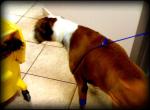
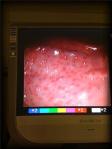
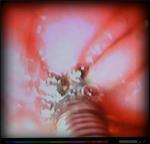
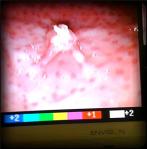
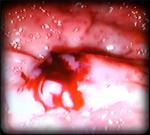



How is the dog doing now? My 10 yr old female foxhound mix, Bailey, just has the same thing. She had her spleen along with the tumor removed on 03-18-10 and is doing well. The Dr. said her liver, kidneys, lungs & heart all look unaffected but called me this morning & said the lab results are a splenic leiomyocarcoma & appears to have been isolated to just the mass in her spleen. We will need to keep an eye on her & do ultrasounds on a regular basis to keep an eye on possible spread. He says this cancer does not spread very aggressively but everything I’ve read says otherwise.
Hi Rachel,
I hope Bailey does great for a long, long time.
My patient is doing well. He visited the veterinary oncologist and she prescribed some chemotherapy for about 6 weeks to help decrease any potential cancer that may have spread microscopically. Apparently, many oncologists advise this chemo, but there is no solid proof that it extends life. He’s doing really well with it.
Many specialists I’ve spoken with have leiomycosarcoma patients that live for 4-5 years after surgery. Be careful what you read! Keep positive.
–Doc Truli
Just wondering how these pups with the splenic leiomyosarcomas are doing. My 5 yr old cocker spaniel had surgery 3 weeks ago for this problem. She shows no sign of metastis and she recovered very well from surgery. All her tests, echocardiogram, 3 chest xrays, ultrasound and liver biopsy all clear. We changed her diet to high protein, no grain diet and we are giving her a daily multivitamin supplement. Her new treats, which she loves, are made from 90% fish, which is loaded with omegas. Her fur has come back silky smooth!! And we are having 5 treatments of chemo starting tomorrow. But I have kids and I am worrying about her getting sick. By the way, we found the lump by accident and she was showing no signs or symptoms of anything. Thank goddness she loves to get belly rubs and we found it!!!
Wow! You guys have good fingers to feel a splenic lump. That’s amazing! It sounds like your Cocker is doing great. My patient is doing well. He had the rounds of chemotherapy that the board certified oncologist recommended. He handled the chemo without any problems. White blood cells never plummeted, he didn’t get sick from the chemo until the last treatment. That time, he felt a little tired and did not want to eat (unusual for a Boxer).
Your girl could get sick from the chemo. I’m sure your oncologist explained the pros and cons to you. Just remember, your decisions about whether or not to do chemo will not “save” or “kill” her. I know you’re probably worried that if you say no to chemo, and she gets metastasis, you’ll feel like you should have done the chemo. And if you do the chemo and she feels sick, that maybe she would have been fine without it and then you went and made her sick. Right? That’s pretty much the dilemma.
Remember that she had a leiomyosarcoma. That cancer is responsible for any negative outcomes, not your decisions either way! Just do what you think is right!
BTW – my patient had an intestinal leiomyoma successfully removed when he was 4 years old, and he was doing good until at 8 yrs, the leiomyosarcoma became apparent. The pathologist told me that sometimes the leiomyomas, which are benign, non-spreading tumors, are misidentified by the specialists. He said it was possible that was a leiomyosarcoma four years before the new cancer! That one stayed away without chemo for 4 years (we did twice a year abdominal ultrasounds, and the yearly bloodwork). At the second surgery for the bad cancer, the surgery from the first tumor looked fine!
Good Luck, Anne. You are setting a great example for your kids and treating your dog like the family member she is. I’m sure you’ll make the decision that is right for her!
Keep us updated on how her chemo treatments go.
Yours,
Doc Truli